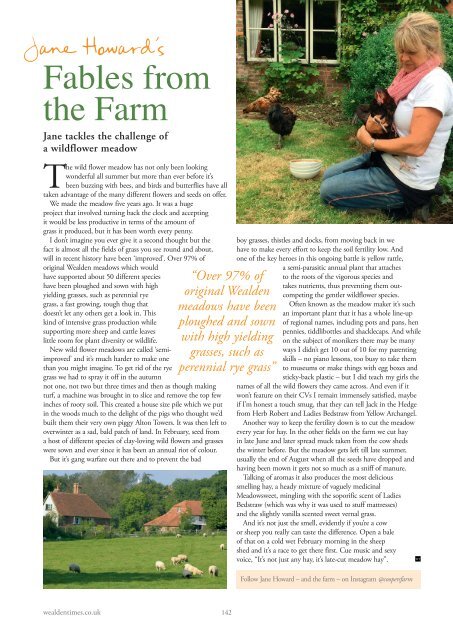Wealden Times | WT210 | August 2019 | Restoration & New Build supplement inside
Wealden Times - The lifestyle magazine for the Weald
Wealden Times - The lifestyle magazine for the Weald
Create successful ePaper yourself
Turn your PDF publications into a flip-book with our unique Google optimized e-Paper software.
Jane Howard’s<br />
Fables from<br />
the Farm<br />
Jane tackles the challenge of<br />
a wildflower meadow<br />
The wild flower meadow has not only been looking<br />
wonderful all summer but more than ever before it’s<br />
been buzzing with bees, and birds and butterflies have all<br />
taken advantage of the many different flowers and seeds on offer.<br />
We made the meadow five years ago. It was a huge<br />
project that involved turning back the clock and accepting<br />
it would be less productive in terms of the amount of<br />
grass it produced, but it has been worth every penny.<br />
I don’t imagine you ever give it a second thought but the<br />
fact is almost all the fields of grass you see round and about,<br />
will in recent history have been ‘improved’. Over 97% of<br />
original <strong>Wealden</strong> meadows which would<br />
“Over 97% of<br />
original <strong>Wealden</strong><br />
meadows have been<br />
ploughed and sown<br />
with high yielding<br />
grasses, such as<br />
perennial rye grass”<br />
have supported about 50 different species<br />
have been ploughed and sown with high<br />
yielding grasses, such as perennial rye<br />
grass, a fast growing, tough thug that<br />
doesn’t let any others get a look in. This<br />
kind of intensive grass production while<br />
supporting more sheep and cattle leaves<br />
little room for plant diversity or wildlife.<br />
<strong>New</strong> wild flower meadows are called ‘semiimproved’<br />
and it’s much harder to make one<br />
than you might imagine. To get rid of the rye<br />
grass we had to spray it off in the autumn<br />
not one, not two but three times and then as though making<br />
turf, a machine was brought in to slice and remove the top few<br />
inches of rooty soil. This created a house size pile which we put<br />
in the woods much to the delight of the pigs who thought we’d<br />
built them their very own piggy Alton Towers. It was then left to<br />
overwinter as a sad, bald patch of land. In February, seed from<br />
a host of different species of clay-loving wild flowers and grasses<br />
were sown and ever since it has been an annual riot of colour.<br />
But it’s gang warfare out there and to prevent the bad<br />
boy grasses, thistles and docks, from moving back in we<br />
have to make every effort to keep the soil fertility low. And<br />
one of the key heroes in this ongoing battle is yellow rattle,<br />
a semi-parasitic annual plant that attaches<br />
to the roots of the vigorous species and<br />
takes nutrients, thus preventing them outcompeting<br />
the gentler wildflower species.<br />
Often known as the meadow maker it’s such<br />
an important plant that it has a whole line-up<br />
of regional names, including pots and pans, hen<br />
pennies, tiddlibottles and shacklecaps. And while<br />
on the subject of monikers there may be many<br />
ways I didn’t get 10 out of 10 for my parenting<br />
skills – no piano lessons, too busy to take them<br />
to museums or make things with egg boxes and<br />
sticky-back plastic – but I did teach my girls the<br />
names of all the wild flowers they came across. And even if it<br />
won’t feature on their CVs I remain immensely satisfied, maybe<br />
if I’m honest a touch smug, that they can tell Jack in the Hedge<br />
from Herb Robert and Ladies Bedstraw from Yellow Archangel.<br />
Another way to keep the fertility down is to cut the meadow<br />
every year for hay. In the other fields on the farm we cut hay<br />
in late June and later spread muck taken from the cow sheds<br />
the winter before. But the meadow gets left till late summer,<br />
usually the end of <strong>August</strong> when all the seeds have dropped and<br />
having been mown it gets not so much as a sniff of manure.<br />
Talking of aromas it also produces the most delicious<br />
smelling hay, a heady mixture of vaguely medicinal<br />
Meadowsweet, mingling with the soporific scent of Ladies<br />
Bedstraw (which was why it was used to stuff mattresses)<br />
and the slightly vanilla scented sweet vernal grass.<br />
And it’s not just the smell, evidently if you’re a cow<br />
or sheep you really can taste the difference. Open a bale<br />
of that on a cold wet February morning in the sheep<br />
shed and it’s a race to get there first. Cue music and sexy<br />
voice, “It’s not just any hay, it’s late-cut meadow hay”.<br />
Follow Jane Howard – and the farm – on Instagram @coopersfarm<br />
wealdentimes.co.uk<br />
142


















